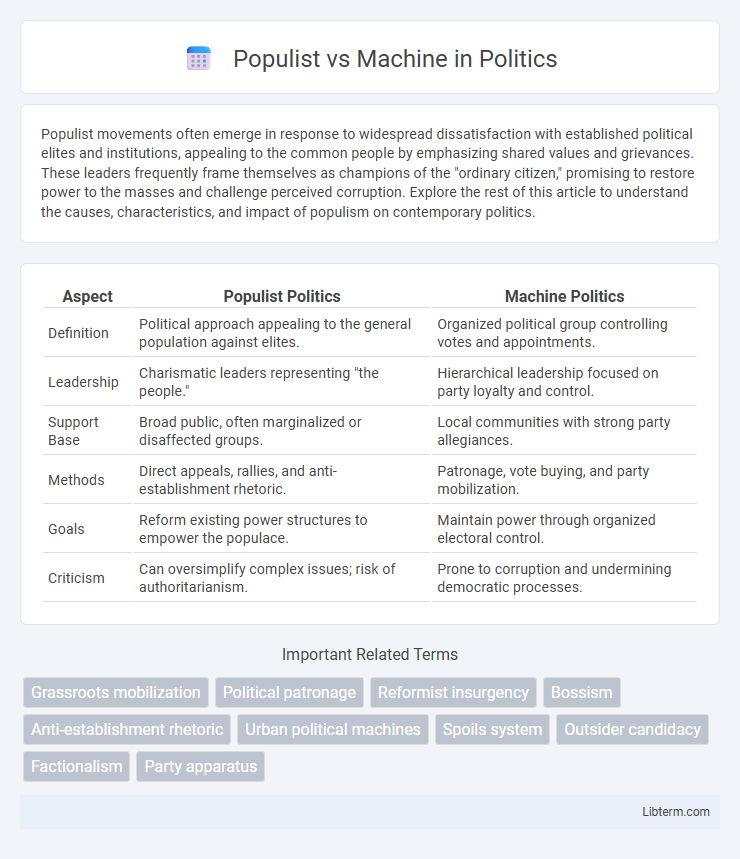Populist movements often emerge in response to widespread dissatisfaction with established political elites and institutions, appealing to the common people by emphasizing shared values and grievances. These leaders frequently frame themselves as champions of the "ordinary citizen," promising to restore power to the masses and challenge perceived corruption. Explore the rest of this article to understand the causes, characteristics, and impact of populism on contemporary politics.
Table of Comparison
| Aspect | Populist Politics | Machine Politics |
|---|---|---|
| Definition | Political approach appealing to the general population against elites. | Organized political group controlling votes and appointments. |
| Leadership | Charismatic leaders representing "the people." | Hierarchical leadership focused on party loyalty and control. |
| Support Base | Broad public, often marginalized or disaffected groups. | Local communities with strong party allegiances. |
| Methods | Direct appeals, rallies, and anti-establishment rhetoric. | Patronage, vote buying, and party mobilization. |
| Goals | Reform existing power structures to empower the populace. | Maintain power through organized electoral control. |
| Criticism | Can oversimplify complex issues; risk of authoritarianism. | Prone to corruption and undermining democratic processes. |
Understanding Populism and Political Machines
Populism centers on appealing directly to the interests and emotions of the general populace, often opposing established elites and advocating for majoritarian democracy. Political machines operate as organized groups that maintain control over political appointments and deliver votes through patronage, often prioritizing loyalty over policy. Understanding the dynamics between populist movements and political machines is crucial for analyzing shifts in political power structures and voter mobilization strategies.
Historical Origins of Populist Movements
Populist movements historically originated in the late 19th century as grassroots reactions against entrenched political machines that dominated urban governance and exploited working-class citizens. These movements, such as the People's Party in the United States, challenged the centralized control of political machines by advocating for direct representation and economic reforms targeting corruption and inequality. Populism's emergence reflects widespread discontent with elite power structures, emphasizing popular sovereignty and mobilizing underrepresented groups in democratic processes.
The Rise and Structure of Political Machines
Political machines emerged in the late 19th century as highly organized entities controlling urban politics through patronage, loyalty, and a hierarchical structure centered around a powerful boss. These machines relied on exchanging material benefits for votes, often targeting immigrant communities to secure a solid voter base, contrasting with populist movements that emphasized anti-elite rhetoric and grassroots mobilization. The hierarchical nature of political machines created centralized control over local government resources, enabling them to maintain power through strategic political alliances and patron-client relationships.
Key Differences: Populist vs Machine Politics
Populist politics centers on charismatic leaders rallying mass support by appealing directly to popular grievances and promising sweeping reforms, often challenging established elites. Machine politics relies on structured organizations that maintain control through patronage, loyalty, and mobilizing voter blocs via established political networks. The key difference lies in populism's emphasis on direct leadership and anti-establishment rhetoric versus the machine's focus on organizational control and sustained political influence.
Strategies for Mobilizing Voters
Populist movements often rely on direct, emotionally charged messaging to mobilize voters by appealing to common grievances and promising radical change against perceived elites. Machine politics employs organized, hierarchical structures that use patronage, incentives, and precise voter targeting to secure loyalty and turnout. Both strategies capitalize on community networks but differ in their reliance on grassroots enthusiasm versus institutional control.
Notable Leaders: Populists and Machine Bosses
Populist leaders like Huey Long and Bernie Sanders emphasize grassroots mobilization and direct appeals to common citizens, contrasting sharply with machine bosses such as Richard J. Daley and William M. Tweed who wielded power through complex patronage networks and political control. Populists prioritize reform and challenge established elites, while machine bosses maintain power by distributing resources and securing loyalty within urban political machines. The distinct leadership styles of populists and machine bosses illustrate the broader struggle between democratic inclusiveness and entrenched political authority in American political history.
Impact on Policy and Governance
Populist movements often prioritize direct appeals to public sentiment, leading to rapid policy shifts driven by popular demands rather than long-term strategic planning, which can result in volatile governance outcomes. Machine politics relies on structured party organizations and patronage networks, ensuring policy continuity and administrative stability but sometimes at the cost of reduced transparency and innovation. This contrast significantly impacts the effectiveness and responsiveness of government institutions, influencing democratic accountability and policy implementation quality.
Challenges and Criticisms of Both Approaches
Populist movements often face criticism for oversimplifying complex issues and promoting divisive rhetoric that can undermine democratic institutions. Machine politics is challenged by accusations of corruption, patronage, and resistance to reform, leading to voter disenfranchisement and cynicism. Both approaches struggle with balancing effective governance and broad public support while maintaining transparency and accountability.
Modern-Day Examples and Relevance
Populist movements in modern politics often emphasize direct appeals to the general public, leveraging social media platforms to mobilize support, as seen in figures like Donald Trump and Jair Bolsonaro. In contrast, political machines rely on established party structures and patronage networks to maintain influence, exemplified by the traditional Democratic organizations in cities such as Chicago and New York. The relevance of this dichotomy persists in contemporary elections where populist rhetoric challenges entrenched machine politics, reshaping voter engagement and party dynamics worldwide.
The Future of Populism and Political Machines
The future of populism is increasingly shaped by digital platforms that amplify direct voter engagement while challenging traditional political machines reliant on hierarchical structure and patronage. Emerging political technologies enable populist movements to mobilize support rapidly, often bypassing established party apparatuses. However, political machines may adapt by integrating data-driven strategies and sophisticated voter targeting to maintain influence in evolving democratic landscapes.
Populist Infographic

 libterm.com
libterm.com